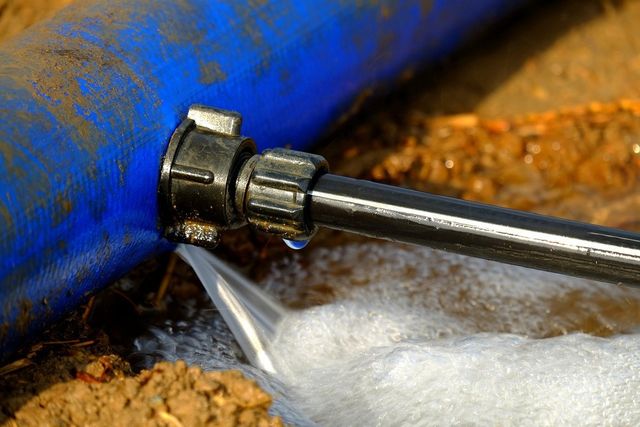Guide To Water Leak Detection At Home
Guide To Water Leak Detection At Home
Blog Article
Just how do you actually feel about Detecting hidden plumbing leaks?

Early detection of dripping water lines can reduce a prospective catastrophe. Aside from conserving you cash, it will certainly minimize the irritation as well as frustration. The moment you find a leak, calling your plumber for repair services is the best service. Some small water leakages might not be noticeable. Below are some hacks that aid if you can not spot it with your nude eyes.
1. Examine the Water Meter
Every home has a water meter. Checking it is a guaranteed manner in which helps you discover leakages. For starters, turn off all the water sources. Ensure no one will certainly purge, utilize the faucet, shower, run the cleaning maker or dishwashing machine. From there, go to the meter and watch if it will certainly alter. Because no person is using it, there should be no motions. If it moves, that shows a fast-moving leak. Likewise, if you find no changes, wait a hr or 2 and also inspect back once again. This suggests you might have a slow leak that can also be underground.
2. Check Water Intake
If you spot abrupt modifications, in spite of your consumption being the very same, it suggests that you have leaks in your plumbing system. A sudden spike in your expense suggests a fast-moving leak.
A stable increase every month, also with the very same practices, shows you have a slow-moving leak that's also slowly rising. Call a plumber to completely check your residential property, specifically if you feel a warm location on your floor with piping underneath.
3. Do a Food Coloring Examination
When it concerns water consumption, 30% originates from commodes. Examination to see if they are running effectively. Drop flecks of food shade in the storage tank and wait 10 minutes. If the shade somehow infiltrates your bowl throughout that time without flushing, there's a leak between the tank and bowl.
4. Asses Exterior Lines
Don't neglect to inspect your outdoor water lines too. Test spigots by affixing a yard hose pipe. Ought to water seep out of the link, you have a loose rubber gasket. Replace this as well as make sure all links are tight. It will aid obtain it skillfully analyzed and also kept yearly if you've got a sprinkler system. One small leakage can throw away lots of water and increase your water expense.
5. Assess the situation and also evaluate
Home owners need to make it a habit to inspect under the sink counters as well as even inside closets for any kind of bad odor or mold and mildew growth. These 2 red flags indicate a leakage so timely focus is needed. Doing routine examinations, even bi-annually, can conserve you from a significant trouble.
More importantly, if you understand your house is already old, maintain a watchful eye on your heaters, hose pipes, pipelines and so on. Look for discolorations as well as deteriorating as most pipes as well as home appliances have a life expectancy. They will certainly additionally naturally deteriorate due to tear and put on. If you believe leaking water lines in your plumbing system, don't await it to escalate. Call a specialist plumber today so you don't end up with a horrible mess in your home.
Early discovery of leaking water lines can mitigate a prospective calamity. Some little water leaks may not be noticeable. Inspecting it is a guaranteed way that aids you find leaks. One little leakage can waste loads of water and also surge your water expense.
If you think dripping water lines in your plumbing system, don't wait for it to intensify.
WARNING SIGNS OF WATER LEAKAGE BEHIND THE WALL
PERSISTENT MUSTY ODORS
As water slowly drips from a leaky pipe inside the wall, flooring and sheetrock stay damp and develop an odor similar to wet cardboard. It generates a musty smell that can help you find hidden leaks.
MOLD IN UNUSUAL AREAS
Mold usually grows in wet areas like kitchens, baths and laundry rooms. If you spot the stuff on walls or baseboards in other rooms of the house, it’s a good indicator of undetected water leaks.
STAINS THAT GROW
When mold thrives around a leaky pipe, it sometimes takes hold on the inside surface of the affected wall. A growing stain on otherwise clean sheetrock is often your sign of a hidden plumbing problem.
PEELING OR BUBBLING WALLPAPER / PAINT
This clue is easy to miss in rooms that don’t get much use. When you see wallpaper separating along seams or paint bubbling or flaking off the wall, blame sheetrock that stays wet because of an undetected leak.
BUCKLED CEILINGS AND STAINED FLOORS
If ceilings or floors in bathrooms, kitchens or laundry areas develop structural problems, don’t rule out constant damp inside the walls. Wet sheetrock can affect adjacent framing, flooring and ceilings.
https://www.servicemasterbyzaba.com/blog/how-to-detect-water-leakage-in-walls/

I am just very interested in Locating water leaks and I'm hoping you enjoyed the blog post. Do you know somebody who is curious about the subject? Take a moment to share it. We cherish reading our article about Hacks to detect leaks.
Report this page